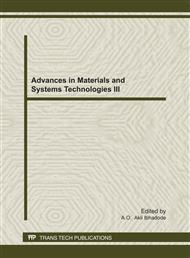p.779
p.795
p.801
p.807
p.815
p.827
p.831
p.839
p.849
Application of Erosion 2D Model for Erosion Studies in Makurdi Metropolis of Benue State, Nigeria
Abstract:
The equations of Erosion 2D Model (a physically based model) were transformed into a computer programme called EROSOFT and used to predict the rate of soil loss in Makurdi metropolis. The model has detachment, transport and deposition components. Four sites were chosen within the metropolis for this study. Soil samples were collected from the sites for laboratory analysis. Rainfall and runoff fluids were collected from the sites to determine their densities. Levelling instrument was used to detremine the channels slopes. The model predicted an average annual soil loss rate of 310kg m-2s-1 for the metropolis. The sensitivity analysis of the model indicates that straight slopes are more prone to soil erosion. The result of the model deviates slightly from established facts that, sandy soils are more erodible and hence prone to be easily detached. Nevertheless, the model shows that soil erosion is influenced by slope geometry and rainfall intensity. The study attributes the major causes of soil erosion in the city to urban runoff concentration and removal of vegetation, and therefore suggests the use of land grading, land forming and cover cropping as well as conservation structures like road side drains for the control of erosion in the metropolis.
Info:
Periodical:
Pages:
815-825
Citation:
Online since:
October 2011
Authors:
Keywords:
Price:
Сopyright:
© 2012 Trans Tech Publications Ltd. All Rights Reserved
Share:
Citation:


